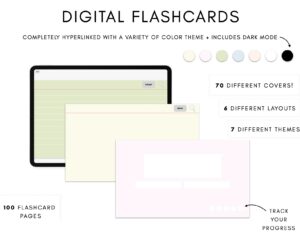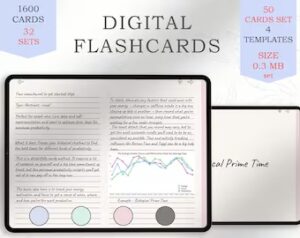In the realm of memorising, digital flashcards are upending conventions.
They are like that friend who is always the best study buddy—a smart, usually humorous, excellent listener.
It’s all about active recall and spaced repetition—prciples so strong they could win medals in cognitive psychology.
Digital flashcard users reportedly have retention rates that soar up to 50% higher than other study techniques.
Imagine it as a personal learning friend that not only guides you but also pulls you up by your bootstraps using text, images, and some audio flair.
Let’s talk about the great advantages of digital flashcards. Here’s a fast and funny summary:
- Portability: Your flashcards are always ready to go right there on your device, like an overly eager dog. You no longer have to try to recall where you left that crumpled-up sheet of paper or carry about bulky books.
- Customising: You are the artist in this case Style your cards exactly the way you want, splash colours, hit those sound buttons. Make it stick like gum on a heated pavement.
- Gamification: Several apps make learning a game. Unlock levels and gather shiny rewards at will. Studying can be enjoyable as well as nose-to–the-grindstone!
- These clever systems save you from last-minute cramming like it’s an Olympic event by pushing just enough at the appropriate times, acting as your personal coach.
Using flashcards lets you avoid simply memorising.
No, your own brain is engaged in memory tug-of- war.
Studies find that active recall increases retention by thirty percent. You could carry that amount to the bank right now.
So hold that idea and consider adding some flashcard creation to your daily study schedule.
To create some visually striking flashcards:
- Create specific questions instead of the nebulous stuff. Think like a well-aimed dart, sharp and deep.
- Use colours and visuals to toss some eye candy—images that linger in your head more than dinner from last night.
- Keep it short: limit one idea on each card. Here you want clarity, not a full-fledged novel. Your best friends are Bullet Points.
Not to mention spaced repetition either.
See those cards at just the right moment to help your knowledge blossom over time, much as watering a plant.
After one day, go back; try again after three days; keep on like an energiser bunny on a mission.
Combining flashcards with notional or evernote tools will help you grasp them better. Here’s how to keep the creative fluids flowing:
- Jot down pearls of wisdom from those flashcards on digital notes. All of it is about connecting those concepts.
- Create Mind Maps; let your inner artist flourish. See how the branches of knowledge link.
- Play Interactive Games: Explore games like Kahoot! Learning with others will be amazing—who knew that learning could be a party?
At last lay down a strong study schedule.
Choose times to go over those flashcards and organise some reasonable objectives to monitor your development.
For instance, keep to daily 15 to 30 minute sessions.
Trust me; regularity is essential and could sharpen your memory more than a tack.
Participate in this learning journey; grab those images, team-style collaborate, and create a routine.
Mastery of memorisation and recall is just around the corner, and I’m telling you, it’s worth every laugh and leaf of study with digital flashcards as your reliable sidekick!
Digital Flashcard: Their Power

Digital flashcards have changed how we pick up and remember knowledge.
They offer a sensible, effective way to use active recall to boost memorisation.
The development of technology has made it feasible for memory aids to be interactive, so improving the ease of learning as well as the enjoyment factor.
Whether they are trying to learn a new language or getting ready for an exam, students and professionals both can make effective use of the many applications at hand for quick learning.
Flashcards inspire a deeper knowledge of the content than only rote memorising.
Spaced repetition, active involvement, and adaptation help one to reach this.
We will discuss their structure, benefits, and fit into our daily lives as we dig into the power of digital flashcards.
Every card acts as a strong link between uncertainty and clarity—a mix of knowledge you can reinforce at your own speed.
Appreciating Digital Flashcards
Designed and studied using many applications, digital flashcards are electronic versions of conventional flashcards.
Their often include text, pictures, and sounds, so providing a flexible learning environment.
Digital flashcards are convenient since their flexibility lets students access them on several devices.
Digital flashcards can comprise many components:
- Text: Definitions, date, or concept core knowledge.
- Images and visuals help in visual memory retention and create more dynamic learning environment.
- Useful for language learners, audio clips include context and pronunciation.
Key ideas in cognitive psychology determine how effective digital flashcards are.
They take advantage of active recall—that is, the learner’s need to access material from memory.
This retrieval improves brain neural connections, so facilitating later memory of the material.
Advantages of Flashcards
Using flashcards offers many advantages that appeal to several learning environments. There are several groups into which they fall:
- Digital flashcards are available anywhere on several devices, including computers, tablets, and smartphones.
- Users can customise their flashcards to suit their style and learning requirement. They allow one to add images, sounds, and colours.
- Many apps use gamification—that is, gamified components—to make learning interesting and enjoyable. This strategy raises drive and lowers burnout risk.
- Flashcards can maximise review sessions by using algorithms, so ensuring learners retain knowledge over longer times.
A study by the National Centre for Biotechnology Information found that using flashcards improved retention by half compared to more conventional study techniques.
This figure emphasises how well flashcards might aid in long-term memory and efficient learning.
How Flashcards Improved Recall
By a process called active recall, flashcards improve memory.
Users actively test their knowledge and try to recall facts from memory rather than merely passively reading material.
This technique stimulates cognitive functions, hence over time information retrieval becomes more successful.
Factors affecting memory improvement with flashcards consist in:
- Users can instantly confirm their responses, so enabling real-time correction of errors.
- Flashcards help to divide difficult material into manageable chunks so as to avoid overwhelming the student.
- Flashcards’ interactive design helps students stay concentrated and involved, so preventing the natural drift tendency.
Studies conducted at the University of California, Los Angeles show that students who combine active recall strategies with flashcards may remember 30% more than those who only use passive review techniques.
Popular Flashcard Tools
Modern digital flashcard applications abound and each have special advantages and features. Among often used applications are:
- Anki is a well-known platform that over time helps reinforce knowledge using spaced repetition techniques. Customising with images, audio, and shared decks from other users also is made possible.
- Quizlet is a simple tool supporting many disciplines. Users of Quizlet can design flashcards, play games, even join study groups.
- Brainscape guarantees that you study at the most efficient intervals by using a special adaptive learning algorithm that emphasises on the timing of your review sessions.
- For group learning, Cram is a great option since it offers several study techniques including shared flashcards from other users.
A poll among academics revealed that the creative designs of digital flashcards help over 85% of students to find their learning environment more fun.
Making Perfect Flashcards

Making good flashcards is a craft combining educational ideas, clarity, and artistic expression.
Well crafted questions and answers enable flashcards to be really effective in promoting deeper understanding and better retention.
Realising the knowledge that has to be acquired comes first. Every flashcard is created from clear, succinct definitions and explanations. Users should refrain from stuffing every card with too much data; simplicity will greatly improve memory and understanding.
The Craft of Writing Questions
Effective flashcards have their framework in the construction of focused questions.
A well-written question stimulates critical thinking and starts the educational process.
Advice on building Questions:
- Be precise; avoid open-ended questions. Rather, directly and clearly probe the content.
- Use keywords: To help fast recall, concentrate on those that really reflect the core of the topic.
- To vary the kind of cognitive involvement, include multiple-choice questions, fill-in-the-blank forms, or open-ended questions.
Examples of good questions are:
- Rather than posing “What is climate change?”You could wonder “What are the main greenhouse gases causing climate change?”“
- Add contextual questions, like “What events led to the establishment of the U.S.,” instead of basic vocabulary flashcards. constitution?— “
Employ Images and Colours
Flashcards with visual components help to greatly increase memory retention.
Images speed our brains more than text, thus using images can more effectively transmit information to long-term memory.
Advice for Employing Visuals:
- Choose pictures that directly connect to the subject matter. During study sessions, a picture of a historical person can help to solidify their importance.
- Use colour-coding to group several themes or subjects. Colours can cause feelings, set memories ablaze, and assist in information separation.
- Where appropriate, use flow charts or diagrams to graphically visualise difficult ideas, so simplifying otherwise dense material.
Studies reveal that students recall images far more precisely than they would text by itself.
Students who combined images with their textual material kept up to 65% of the information in a study reported in the Journal of Educational Psychology, compared to 10% with text-only.
Maintaining Its Concision
For good flashcards, concision is absolutely essential.
Every card should have just necessary data to avoid cognitive overload.
Best Standards for Concision:
- Limit Every Card to One Concept: To help clarity and concentration, every flashcard should centre on one idea or question.
- Shortening terms or applying mnemonics can help one easily absorb and recall difficult material.
- Use bullet points for lists or key terms to visually appeal and simplify review of lists or important terms.
Imagine the following:
- Bad Flashcard: “Photosynthesis is the process whereby green plants use chlorophyll in their leaves to absorb sunlight, so transforming it into energy.”
- Good Flashcard: “Photosynthesis: Process by which plants use sunlight to convert CO2 + H2O into glucose + O2.”
Users improve their study sessions greatly by keeping simple formatting and short language.
Using spaced repetition
Using spaced repetition—that is, learning—one studies material at ever-increasing intervals across time.
It challenges the forgetting curve, a hypothesis holding that, without effort to preserve information, it is lost over time.
Including spaced repetition into your study schedule will help you noticeably increase memory and retention.
What is repetition spaced apart?
Using the psychological spacing effect, spaced repetition shows that, rather than cramming, repeated exposure is more effective in helping one retain material.
This approach lets students review ideas at well chosen intervals, so strengthening memory pathways.
- The basic idea is that spaced repetition suggests going over flashcards less often the more they are remembered, rather than daily review of the same material.
- For flashcard review, use an interval increase—that is, go back over cards one day, then three days, a week, then two weeks.
Students who want to apply this might think about using algorithms found in programs like Anki, which evaluate the recall of every card and modify the intervals.
Spaced Learning: The Science
Extensive study on learning strategies by behavioural science has shown how closely spaced repetition affects memory retention and recall.
Important results consist in:
- Proposed by psychologist Hermann Ebbinghaus, the forgetting curve shows how information loss proceeds without reinforcement, usually around 70% within 24 hours.
- Retain More: Comparatively to massed practice, spaced repetition has been found to double retention rates. According to the studies, methodically going over material at regular intervals helps to steady learning.
Subjects who used spaced repetition remembered 30% more information than those who used continuous recall techniques, according a study written up in the journal Psychological Science.
Instruments for Consistent Repetition
Different tools help students to efficiently simplify their study processes by facilitating spaced repetition.
Advised Instruments:
- Anki: Using an advanced algorithm to time your reviews, Anki—one of the most revered programs for spaced repetition—is discussed here already.
- Quizlet comprises a “Learn” mode meant to maximise recall by varying challenge and repetition interval depending on performance.
- Pioneer in spaced repetition software, SuperMemo’s algorithms support a customised learning schedule dependent on memory performance.
Most of these tools feature statistics and performance tracking, which lets users observe how recall changes with time.
Improving Memorisation with Other Digital Tools
While digital flashcards are great for memorising, other digital tools enhance this approach by covering many facets of learning.
Notes Taking: Notion and Evernote
Strong note-taking tools with great information organising capability are Notion and Evernote.
- Notion: combines project management with note-taking. Users can create databases, develop knowledge bases, and perhaps include flashcards.
- Renowned for their organisation skills, users may clip web pages, add images, and sync notes across devices for easy access.
These instruments enhance a whole learning experience when used with digital flashcards.
By gathering background and forging closer relationships to the material they study, students can excel in their comprehension.
MindMapping Tools: XMind and MindMeister
Mind mapping tools such as MindMeister and XMind help one to see difficult relationships and ideas.
They improve understanding by helping students see the whole picture and forgive links between ideas.
- MindMeister is really great for group mind mapping. It lets users create, distribute, and update real-time maps.
- XMind can also interface with other platforms to centralise data and provides a rich formatting experience including brainstorming tools.
Mind maps combined with flashcards improve memory retention by visually appealing, easily digestible format of presenting material.
Educational Games: Kahoot! and Quizlet
Gamification of learning transforms conventional approaches by including fun and competition.
Kahoot! and Quizlet offer interactive learning reinforcement activities.
- This function of Quizlet Live generates an interactive game whereby users may learn cooperatively and compete in teams.
- Kaoot!Fun quizzes and games similar to trivia let students reinforce knowledge while still enjoying the learning environment.
These systems use players’ natural competitive drive to turn study sessions into interesting events enhancing memory and retention.
Creating a Research Agenda
Good learning is mostly dependent on a disciplined study schedule.
Establishing a focused study plan not only guarantees time for flashcard preparation but also advances a methodical approach to concept mastery.
Scheduling Flashcard Review’s time
Developing discipline in your study process depends on setting aside particular times for flashcard review.
Advice on efficient time management:
- Daily Sessions: Try for quick, concentrated ones. Studies point to 15 to 30 minutes daily maximizing retention without burnout.
- Plan consistency: Keep to the same review time to develop a habit, so promoting more discipline and advancement.
- Apply the Pomodoro method, allowing study for 25 minutes then a 5-minute break to improve concentration.
Making a balanced calendar results in slow, long-term learning instead of cramming, so improving retention.
Combining Flashcards with Different Approaches to Learning
Combining flashcards with other study techniques enhances learning opportunities.
Combining approaches allows for many learning styles and deep comprehension.
Recommended combinations comprise:
- Grouping with friends can help to improve recall by means of debate and quiz sessions.
- Along with flashcards, use self-testing strategies to find areas of knowledge lacking.
- Record significant insights from flashcard sessions using note-taking tools to link material in several forms.
These combinations guarantee different engagement, so maintaining the dynamic and successful nature of your study schedule.
Recording Your Development
Tracking development gives the student concrete proof of learning, which drives them even more.
Tracking tools found in flashcard applications let students see areas needing more attention and areas showing development.
Tracking Advancement Strategies:
- App analytics let you see how much content has been mastered.
- Set aside time each month to evaluate performance and modify your methods depending on known and unknown material.
- To keep motivated and keep responsibility, set well defined, reasonable goals for particular time periods.
Participating actively in your development will help you to make study sessions fulfilling events, so improving recall.
Advice for Optimal Recall
Engagement of several senses during the study process helps to maximise recall.
Learning strategies that activate several sensory experiences can help to improve memory and comprehension.
Inviting Many Senses
Including several senses into your study will help you to strongly imprint knowledge into your memory.
Techniques involving senses include:
- Visual learning calls for text alongside pictures, videos, and diagrams. Visual cues give context that improves memory.
- Record yourself reading flashcards aloud in Auditory Learning. Through auditory processing, listening helps memorisation be reinforced.
- Integrate movement in kinaesthetic learning by making flashcards with physical actions, such as hand gestures to help you remember details on a historical event.
Students using multimodal learning strategies retained 50% more information than those using just one approach, according a study by the New Jersey Institute for the Deaf and Hard of Hearing.
Group Research with Digital Tools
There are really great advantages from cooperative learning.
Group discussions of material have been found in studies to greatly raise retention rates and deepen understanding.
Advice on successful group studies:
- Work on flashcard reviews using Digital Platforms like Zoom or Microsoft Teams. Share ideas and justifications to support understanding.
- Peer instruction helps you to confirm your knowledge. Making flashcards together can produce fresh ideas and knowledge.
- Group Challenges: Using tools like Kahoot!, include competitive games connected to the material! Quizlet Live helps to increase drive and concentration.
Group studies improve memorisation as well as offer social interaction, so strengthening the learning process.
Consistent Self- Testing Methods
Regular self-testing has to be included into study schedules.
Testing yourself helps to spot knowledge gaps and supports learning.
Techniques for Personal Evaluation:
- Plan frequent tests spaced after your review sessions. After one day, three days, one week, then following weeks, test yourself.
- Use alternate multiple-choice, true/false, and flashcard questions on self-tests to increase recall variety.
- Retrieving answers without first looking at them will help you to develop confidence and endurance by simulating exam conditions.
Regular self-testing helps students retain information by about 30%, according to studies from the University of Illinois, so enhancing recall.
Analysing Your Performance
Any learning process depends critically on evaluation of success.
Knowing how to evaluate memory retention will enable one to modify methods for best results.
Assessing Memory Retention
Realising areas of development calls for a strong awareness of memory retention levels.
Many ways exist to methodically assess retention.
- Pre- and post-test evaluations help to gauge knowledge development by means of both before and after a study period.
- Track how many flashcards are routinely recalled precisely to indicate mastered knowledge.
- Encourage self-awareness to monitor emotional reactions and confidence in recall capacity.
Studies show that students who track their retention rates can change their study strategies over time to fit their particular learning styles.
Examining Performance Metrics
Performance measures give you thorough understanding of how well your study strategies work.
Most digital flashcard applications track development using analytics.
Important Performance Measures to Examine:
Recall Rate: % of responses correctly recalled during review sessions.
Error Analysis: Point up areas requiring more in-depth attention by noting which flashcards were routinely wrong.
Time Invested in Review: Examine how much time you spent learning and how that relates to retention outcomes.
By means of these measures, students can make deliberate changes to their study strategies, so ensuring that their learning needs are sufficiently addressed.
Changing Methodologies Based on Outcomes
Effective learning depends on adaptation.
Study plans must be adjusted depending on examined performance measures and retention assessments.
Advice on Changing Methodologies:
- Emphasise weak areas and give difficult ideas more of your time. Add other materials to strengthen knowledge in these spheres.
- Change Flashcard Approaches: Think about varying forms or adding more variation in images and sounds if some cards show poor social interaction.
- Try different time slots or duration for studying if specific study plans are not working.
By means of constant introspection and adaptation, education becomes a more fruitful path generating chances for enhanced learning and long-lasting memory.
What do we believe?
They are evidence of how interactive and interesting study strategies might cause appreciable retention increases.
Adoption of digital flashcards becomes essential for both students and professionals since studies showing a 50% increase in information retention compared to conventional study techniques.
Their adaptability to many learning environments, simplicity, and ease make them great instruments in our toolkit for instruction.
Furthermore, the combination of methods including spaced repetition increases the potency of flashcards.
According to studies, using such strategies helps students fight the forgetting curve and promote a strong and long-lasting knowledge of the content throughout time.
Regular use of these instruments can result in up to a thirty percent increase in recall rates.
The scientific basis supporting these approaches not only calms students but also inspires them to embrace these approaches actively and deliberately.
Beyond flashcards, augmenting tools and techniques including mind mapping and note-taking apps enhances the learning process.
Using a multimodal approach to study—that which combines visual, auditory, and kinaesthetic components—learners can imprint knowledge deeper into their memory.
The data showing that multimodal students remember 50% more highlight the need of varying approaches of learning.
These approaches taken together form a whole framework that goes beyond conventional research paradigms.
Maxing the advantages of digital flashcards and other learning tools ultimately depends on developing a methodical study schedule.
Students can develop a reflective and adaptive learning environment by closely monitoring development and changing their approaches depending on performance criteria.
With digital flashcards and their accompanying techniques, the road to successful memorisation and recall becomes a fulfilling one that not only improves academic performance but also promotes a lifetime passion of learning.
Commonly Asked Questions
Describe digital flashcards?
Digital flashcards are electronic incarnations of conventional flashcards.
To help memorising and recall, they might include text, pictures, and audio components.
Accessible on several devices, they offer an interactive and handy learning environment.
In what ways might digital flashcards improve memory?
Digital flashcards improve memory by means of active recall strategies.
Their tests of information retrieval help to strengthen brain neural connections.
Cognitive overload control and immediate feedback help students to stay interested and concentrated.
Using digital flashcards has advantages what ones?
Among the advantages are gamification, portability, customising, and spaced repetition application.
They are successful for many disciplines and study requirements since they accommodate several learning styles.
Describes spaced repetition?
Reviewing material at ever increasing intervals over time is the method known as spaced repetition.
By means of methodical revisiting of ideas, this approach addresses the forgetting curve and facilitates more efficient information retention by learners.
Which are some well-known flashcard utility apps?
Among the widely used flashcard applications are Anki, Quizlet, Brainscape, and Cram.
To suit various user tastes, each provides special features including gamified learning experiences, spaced repetition techniques, and cooperative options.
How can I design strong flashcards?
Make sure your questions and answers are clear and concise if you want great flashcards.
To improve understanding and recall, use particular, focused questions, include images or colours, and concentrate one idea per card.
How might using several senses help one learn?
Using many senses confirms memory of knowledge.
Combining visual, aural, and kinaesthetic techniques produces a more immersive learning environment and aids in memory reinforcement via several cognitive paths.
Could group flashcard-based study sessions improve my learning?
Group study sessions do indeed greatly improve learning.
Using digital flashcards, cooperative discussions and competitive activities strengthen knowledge and increase the interesting nature of the study process.
For self-testing, what methods might I employ?
Use interval testing, different question forms, and try to remember responses without looking back to properly self-test.
This creates confidence in retention skills and replays exam conditions.
Using flashcard study strategies, how successful can I be?
Tracking card recall rates, assessing memory retention by pre- and post-tests, and examining performance statistics inside your flashcard program will help you determine your success.
These realisations enable you to modify your approach of learning for best results.







